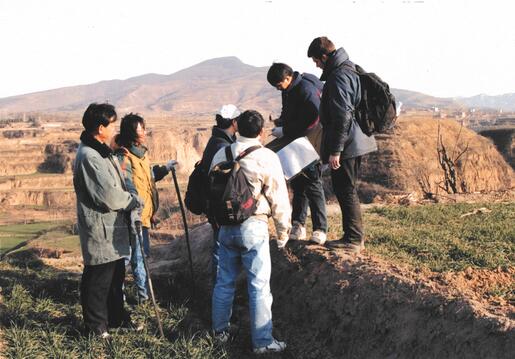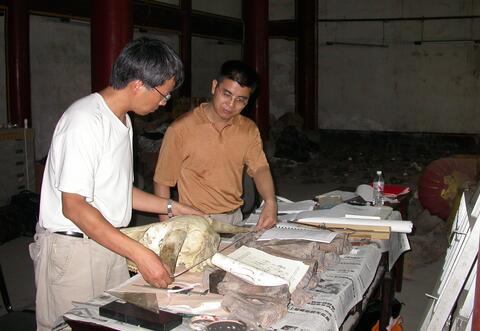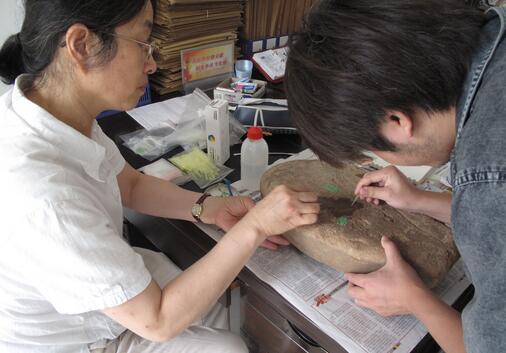The Archaeology of China: From the First Villages to the First States
From:Shanghai Archaeology Forum NetWriter:Date:2017-12-15
The book, The Archaeology of China: From the Late Paleolithic to the Early Bronze Age, published in 2012 by Cambridge University Press in the Cambridge World Archaeology Series, was a decade-long research project. The initial book proposal was submitted in 1997, then revised in 2003; the manuscript was completed and submitted to the press for review in 2010, followed by a one-year long revision; the final version of the manuscript was submitted and accepted in 2011.The book covers a period of more than 20,000 years of Chinese prehistory and early history, focusing on several fundamental questions in human evolution: the origins of agriculture and sedentism, the origins of social inequality, and the origins of early states and cities. This was a very long and slow processes, involving evolutionary trajectories from the last Paleolithic hunting-gathering groups, through Neolithic farming villages, to the Bronze Age Shang dynasty. The book illustrates how ancient societies during this period transformed from simple to complex, tribal to urban, “uncivilized” to “civilized,” and preliterate to literate.

Thanks to rapidly advancing research and technology in China, the available information on archaeology is extremely rich. To write this book, we visited many sites and talked to numerous archaeologists who were active in fieldwork all over China. These communications greatly improved our knowledge about new discoveries in different regions. We made every effort to cover the most up-to-date archaeological data up to the time when the manuscript was completed (2011). A significant amount of the data and interpretations in this volume was derived from our own research projects conducted during the past 20 years, which involved international collaborations among many scholars and students. Here we briefly describe two of our projects, as follows.
The Yiluo Region Archaeology Project:
This project aimed to investigate the long-term social, economic, and political changes in the heartland of Chinese dynastic civilization, focusing on the Yiluo basin. It is a multi-disciplinary research project, involving many experts from China, Australia, the United States, England, and Canada. Their expertise includes full-coverage regional survey, geo-archaeology, geology, archaeobotany, zooarchaeology, soil micro-morphology, and ceramic analysis. The project consisted of two programs: the full-coverage survey of the Yiluo region and the excavation of a stone-tool production center at the Huizui site in Yanshi. Our survey team worked with the Erlitou Archaeology Team, together covering the entire Yiluo basin (about 850 km2). More than 410 sites were recorded, dating from the Peiligang culture to the Eastern Zhou period (ca. 6000-200 BC). The settlement patterns indicate a continuous but fluctuating development of social complexity, indicated by the changes in population size and settlement hierarchy. The most important social change appeared during a period from the Late Longshan to the Erlitou culture, characterized by growing population, increase of settlement hierarchy from three to four tiers, and an urban center rapidly established at Erlitou. These developments in the Yiluo basin are in a sharp contrast to the surrounding regions, where population decline was a common phenomenon.
The results from this survey program revealed a significant social transformation during the second millennium BC, representing the process of early state formation and urbanization in the Central Plain. The occurrence of settlement nucleation and urbanization in the Yiluo basin partially coincided, in time and space, with the Xia and Shang dynasties recorded in the ancient texts. These findings greatly contributed to our understanding of sociopolitical change relating to state formation and early dynasties in north China, which was an important but controversial topic discussed in the book.

Archaeology of food: the exploitation of the wild resources and the origins of agriculture
The origins of food production was another topic in our research projects, as agriculture helped build an economic foundation for the development of social complexity. We developed projects focusing on use-wear and microbotanical analyses of stone tools, in order to understand how prehistorical people exploited wild foods and domesticated plants. Working with specialists, we analyzed grinding stones from sites ranging from the late Pleistocene (Shizitan in Shanxi), early Holocene (Shangshan in Zhejiang and Donghulin in Beijing), and middle Holocene (Egou and Shigu in Henan), and revealed diverse strategies of food exploitation in different regions through time. We found that Paleolithic people exploited not only wild cereals, such as wild millet, but also collected various tubers and beans during the late Pleistocene, then began to add acorn into their diet at the onset of the Holocene when the climate became warmer and wetter. The early Neolithic people continued to use many wild plants, similar to their Paleolithic predecessors, although cereal domestication was already underway. These results help us to understand two important social changes in Chinese prehistory. First, Paleolithic populations had already adopted broad-spectrum subsistence strategies long before the beginning of the Holocene, as was first proposed in the original concept. Second, Neolithization was a very long process rather than a revolutionary event, as V. Gordon Childe originally described. These new data enriched our knowledge when writing the chapters on transition to agriculture in the book.
This book was written for scholars and students in English speaking regions, who are not necessarily specialized in Chinese archaeology. Therefore, we intended to present a broad picture about ancient China, which can be viewed from a comparative perspective. For example, unlike the Mesopotamian civilization, in which external trade for obtaining both subsistence necessities and prestige goods was essential for its economy as well as for the formation of its political systems, ancient people in China largely relied on rich local resources for subsistence needs. Such relatively self-sufficient regional economic modes, nevertheless, were accompanied by active, long-distance exchange of luxuries and scarce raw materials, during prehistory as well as in early historical times. These activities were closely related to ritual practices involving certain types of prestige items, particularly those made of jade and bronze. Such ceremonial patterns would have helped to shape common belief systems, ritual behaviors, and symbolic assemblages over a broad region during the formative period of Chinese civilization.
Throughout the book, we illustrated the long, bumpy, and multidirectional pathways to Chinese civilization. This civilization has experienced great environmental challenges, episodic rise and fall of complex societies, social conflict and political controversy, unintended social transformations, and foreign influences. We may never be able to demonstrate how “Chineseness” was formed or to fully understand what “Chineseness” was in ancient times. In addition, there are always more research questions than answers. We hope that this book may help to open a window that allows us to see more clearly the long social progress of more than 8,000 years, during which small villages were transformed into a great civilization in the land that we call China today.

Biographic Sketches
Li Liu received a BA degree in archaeology from the Department of History at Northwestern University, Xi’an, in 1982, and worked in Shaanxi Provincial Institute of Archeology from 1982 to 1983. She received an MA degree in Anthropology at Temple University in 1987 and a PhD degree in Anthropology at Harvard University in 1994, both in the USA. She then taught in the Department of Archaeology at La Trobe University in Australia from 1996 to 2010, and was elected as Fellow of the Academy of Humanities in Australia in 2008. Since 2010, she has been a professor in the Department of East Asian Languages and Cultures at Stanford University in the USA. Her research mainly focuses on archeology of early China, cultural interaction between China and other parts of the Old World, domestication of animals and plants, early state formation and social complexity, settlement archeology and early urbanization. In recent years, she has been working on microbotanical and use-wear analyses on stone tools and pottery. She currently leads the archeology team at Stanford University to study the origins and development of alcoholic production and consumption in prehistoric China. She has published three monographs (two are co-authored with Xingcan Chen): State Formation in Early China. London: Duckworth, 2003 (translated into Korean in 2006); The Chinese Neolithic: Trajectories to Early States. Cambridge: Cambridge University Press, 2004 (translated into Chinese in 2007); The Archaeology of China: From the Late Paleolithic to the Early Bronze Age. Cambridge: Cambridge University Press, 2012 (translated into Chinese in 2017). The last book is so far, the most comprehensive English book on Chinese archeology. She has also published more than 100 book chapters and journal articles, including 65 in English, French, and Spanish, and 36 in Chinese. These articles, many of which are co-authored with other specialists, covered a wide range of topics.
Xingcan Chen is Senior Fellow and Director of the Institute of Archaeology at the Chinese Academy of Social Sciences and also Chair and Professor in the Department of Archaeology at CASS’s Graduate School, Chinese Academy of Social Sciences (CASS), Beijing, China. He has been working in the middle Yellow River Valley in China for more than 25 years and excavated Lilou, Beiyangping, Xipo and Huizui sites. His main interests include the rise of agriculture, state formation, history of archaeology, theory and method of archaeology and ethnoarchaeology. He has published numerous articles, books and monographs. Among his various publications are The History of Chinese Prehistoric Archaeology (1895-1949) (in Chinese, 1997, in Korean, 2011), Essays on Archaeology (in Chinese, 2002), State Formation in Early China (co-authored with Li Liu, 2003; in Korean, 2006), China Before China (co-authored with Magnus Fiskesjö, 2004), Papers on the History of Chinese Archaeology (in Chinese, 2009), Essays on Archaeology II (in Chinese, 2010) and The Archaeology of China: From the Late Paleolithic to the Early Bronze Age (co-authored with Li Liu, 2012; in Chinese, 2017).

